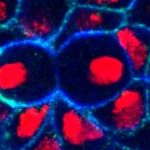Link to Pubmed [PMID] – 9171444
Perspect Dev Neurobiol 1997;4(4):305-11
The Notch protein (N) acts as a transmembrane receptor for intercellular signals controlling cell fate choices in vertebrates and invertebrates. Genetical and molecular evidence indicates that, during Drosophila neurogenesis, an evolutionarily conserved transcription factor, Suppressor of Hairless [Su(H)], transduces the signal of N activation by its ligand Delta (D1). Su(H) plays a direct role in the immediate response of the genome to N signaling by up-regulating the transcription of the Enhancer of split Complex [E(spl)-C] genes. These findings suggest that the N transduction pathway can be described as a simple, linear cascade of molecular activation. At the molecular level, the mechanism of Su(H) “activation” is yet unknown. Two non-exclusive models have been proposed. In the first one, Su(H) binds to inactive N at the membrane. The binding of D1 to N in the extracellular space somehow interferes with the N-mediated cytoplasmic retention of Su(H), resulting in the nuclear translocation and “activation” of Su(H). In the second model, DNA-bound Su(H) is proposed to be “activated” in the nucleus by the direct binding of a processed form of N, acting as a transcriptional coactivator. This nuclear N protein would be generated by the ligand-induced proteolytic cleavage of the N transmembrane receptor.

